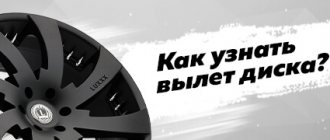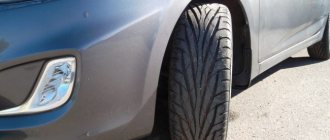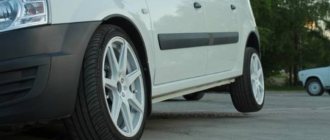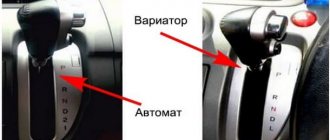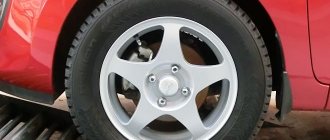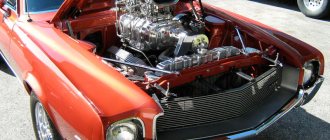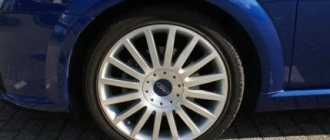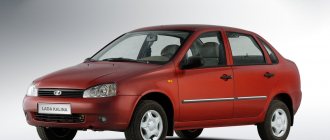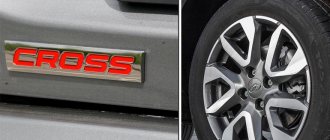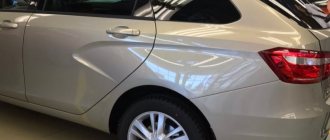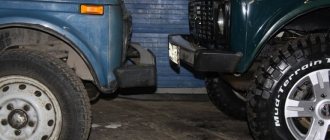The vast majority of car owners are thinking about changing the appearance of their car. And they often start with a simpler and more affordable tuning - replacing stamped wheels with beautiful cast ones. When choosing a disc, many drivers focus on the appearance and diameter, but do not think that there are other important parameters, deviation from which can negatively affect the technical condition of the car and even the handling. An important, but little known parameter is the disc offset - ET.
Disc ejection: what is it?
Disc offset, or ET indicator, is a dimensional parameter that is indicated on the rim of the product, regardless of its radius or material of manufacture (stamped, cast or forged), and indicates the distance from the mating plane of the wheel to the attachment point to the hub.
This dimension is usually set by the car manufacturer. First of all, the wheel must be completely hidden under the wheel arch, and it is the ET indicator that regulates its position - the larger it is, the more the wheel is recessed under the wing; the smaller, the more noticeably the disk protrudes beyond the dimensions of the body.
ET offset on wheels: what is it and how does it affect the suspension and other parts in the car? Depending on the wheel offset, the load on the hub and the bending moment applied relative to it at the base of the suspension are distributed differently. Thus, each automobile concern dictates the strength limit for its parts, which determines the range of wheel offsets.
Some cars, especially when it comes to SUVs and sports cars, are equipped with additional plastic mud flaps, which determine the wheel offset, which in such cases can be zero or even negative, which gives the “iron horse” a very impressive look.
ET departure using 3 indicators as an exampleImportant! Before purchasing a wheel rim, the driver needs to read the owner's manual for his car or study detailed information on numerous Internet resources in order to make the right choice and not regret it later.
Types and mechanical characteristics
There are 3 types of wheel offset:
- null;
- positive;
- negative.
The offset coding (ET) is located on the surface of the rim, and the numbers located next to it indicate its parameters.
A positive offset value means that the vertical axis of the wheel rim is at a certain distance from the point of contact with the hub.
The zero ET parameter indicates that the disk axis and its mating plane are identical.
With a negative ET parameter, the disk attachment surface to the hub moves beyond the vertical axis of the disk.
The most common disc offset is a offset with a positive value; a negative offset, on the contrary, is extremely rare.
The offset size is a significant nuance when designing wheel rims, so a special formula is used to calculate it to eliminate possible errors.
How is ET disc offset measured?
The parameter is measured only in millimeters. You will need a ruler and a wooden (or metal) strip, the length of which coincides with the radius of the wheel.
- First of all, you need to remove the wheel from the car and put the car on the handbrake. If the wheels have alloy wheels, the procedure will be greatly simplified, since all the nuts on them are open. Otherwise you will have to remove the cap.
- Now you can remove the disc from the wheel. This must be done with a sharp movement.
- The wheel should be placed on the ground with the side opposite the hub. We place a wooden strip on top of the disc rim.
- Then, using a ruler, measure the distance from the surface in contact with the hub to the bottom of the rack - this will be distance A.
- Next, we turn the other side of the wheel towards the ground, and also place the rack on the rim.
- We measure the distance from the bottom of the rack to the plane beyond which the hub is distance B.
Formula and labeling
The term disc overhang is designated by the letters ET from the German Einpress Tief (extrusion depth). Its calculation formula is as follows:
ET=ab/2
where a is the distance between the inner plane of the disk and the part that comes into contact with the hub, b is the width of the disk. You can see it most clearly in the figure below.
The calculation is made in millimeters. In some cases, instead of the letters ET, the disc offset is marked with the following inscriptions: DEPORT or OFFSET. For example, the following values may be: ET0, ET30, ET-15.
Varieties of departure
There are three types of offset, each of which is assigned a corresponding marking (painted on the inside of the disk):
- ET20 (zero offset) - when the surface with which the disc is pressed against the hub coincides with the central plane of the wheel,
- ET0 (positive offset) – the vertically located axis of the disk is distant from the point of contact with the hub by a certain distance,
- ET-20 (negative offset) - when the surface with which the disc is attached to the hub is carried beyond its vertical axis.
Today the most common disc offset is ET0. Negative and zero offsets, on the contrary, are rare. Wheels with such an offset are installed on specially prepared cars, for example, for racing, both off-road and on tracks.
The offset parameters are regulated by vehicle manufacturers, and, as they say, there should not be any deviations (even a few mm). Otherwise, the operating conditions of all suspension units change, which under critical load conditions can lead to tragedy.
ET on disks - what does it mean and how is it calculated
The designation in the form of two letters of the Latin alphabet ET is not accidental, since this value is international and is determined by the following formula and is expressed in mm, regardless of the country of the disk manufacturer:
You might be interested in this About wheel bolt pattern on Toyota
ET = X – Y/2,
Where X is the distance from the outer mating plane of the disk to its inner edge on the side of attachment to the hub or the size that is determined by measuring from the side edge of the wheel along the sides to its grille.
Y is the overall width of the product along the rim.
Important!
As a marking, wheel manufacturers, as a rule, prescribe this value as ET20, ET35, ET42, etc., and any professional can always read it and define these values.
Disc with negative offset
What does disc ejection affect?
The following quantities are associated with departure:
- Wheelbase.
- Torque applied to a wheel bearing.
Both parameters need to be considered in detail.
Depends on the wheelbase:
- Sustainability. Improves with increasing distance between wheels. For this reason, SUVs have zero or negative offset.
- Controllability. It is the best for the wheelbase that the designers laid down.
The moment acting on the wheel bearing is calculated as the product of 2 quantities:
- The force with which the road acts on the wheel.
- Arm - the distance from the direction of action of the force to the point relative to which it causes rotation.
The road affects the wheel along the entire contact patch, and the total force vector passes through its midpoint. If the tires are not worn out and the wheel alignment is adjusted, this point lies in the central plane of the disk.
Thus, the further the vertical axis of the wheel is from the bearing, the greater the moment acting on it.
What is ET
Let's figure out what ET on rims is and what role this value plays. Car enthusiasts who have recently bought a car most likely do not yet know how important this parameter is. This value can be seen on the rim of the element; it is determined by the manufacturer. The parameter means the distance from the central point on the disk to the place where it is attached to other components of the mechanism. This size is determined by the manufacturer.
The lower the ET value, the more visible the wheel will be from the outside. Given the value of ET, the degree of load on the wheel will be distributed differently. This value is considered an important characteristic for the disk. It affects the safety of the driver and other people while driving. If the offset is selected incorrectly, the main components of the vehicle will quickly fail.
Very often, car enthusiasts make the following mistakes:
- They buy attractive items without taking into account the required characteristics.
- They rely entirely on consultants at the point of sale, who cannot always provide correct information.
- They don't take the labeling into account.
As a result, the mechanism breaks down prematurely and the person exposes himself to danger.
Why install wheels with a different offset?
Installing wheels with a reduced offset helps to increase stability and, as a result, the wheelbase of the car. Thus, the car is able to turn confidently and has high road stability. Some changes to the suspension improve overall ride comfort, but it also changes the operation of springs, levers, brakes, bearing wear, hub wear and other handling parameters.
Sometimes installing wheels with a smaller, relatively standard offset allows you to reduce the weight of the suspension and thereby improve dynamics and fuel consumption in certain modes.
As the offset increases, the track decreases, and if you do this without preliminary calculations, the wheel may simply rest against the brake caliper or touch the inside of the wheel arch.
The increased reach also affects the operation of the suspension units and the chassis of the vehicle. As a rule, wheels of smaller size and diameter are installed on some versions of cars during winter operation, but the effectiveness of this phenomenon has not been proven, and smaller versions are practically not used in the tuning process.
If we talk about which wheels to choose, then in this case it all depends on the car model, tuning capabilities and other factors. There are disks that are made by hot stamping, others - under high pressure and metal processing.
Forged ones are stronger and lighter, but this does not mean that they are suitable for all car models, it all depends on the situation. When choosing a disk, it is necessary to take into account the meanings and interpretation of the markings in accordance with international standards, where:
- ET – Disc Overhang may be designated as Offset Internal or Extending
- B is a measure of the width of the rim between the edges of the rims (measured in inches. 1 inch = 2.34 centimeters
- “J” is a special service symbol that indicates the design features of a particular model
- “D” – diameter of the mounting rail, “d” – diameter of the hole for the wheel hub
It should be added that there are cases when wheels with an increased or decreased offset fit on a standard wheel hub without problems. However, this does not mean that their use will be safe for various suspension elements.
Automaker engineers carefully calculate all aspects of the behavior of the wheel, hubs, shock absorbers, steering ends, levers, etc., so using discs with sizes not recommended by the manufacturer can significantly reduce the overall life of all these parts.
What kind of departures are there?
Zero departure
Zero or neutral offset is obtained when the mounting plane of the disk exactly coincides with its center line. Discs with zero offset are designated ET0.
Positive offset A disc has positive offset when the plane in contact with the hub is in front of its centerline. When viewed directly from the front, discs with positive offsets appear flat or, less commonly, concave. Positive offset is seen on some older cars' rims, where the wheel hub protrudes further than the rest of the wheel. Too much offset can put pressure on the hub and axle and even break these parts.
Negative offset The mounting surface of negative offset discs is located behind the center line of the wheel. In this case, what is visually striking is that the seat is deeply recessed into the disk, and the disk itself seems, on the contrary, to protrude outward. Such discs often have aggressive shapes with many concave elements.
Take into account the disc offset features when buying a new set. Most people buy discs based on their appearance and design, without delving into the ET parameter. And it is very important during installation. Consult with a specialist before purchasing a set of wheels that are more or less offset than the stock ones for your vehicle.
ET number
The letters ET stand for einpresstiefe 一 insertion depth. The ET parameter denotes the amount of overhang - the distance from the mounting plane to the center line in millimeters. This indicator is stamped on the rear spokes or mounting surface of the alloy wheel and is indicated in the markings. For example, let's take a disk labeled 7.5×18/5×105 D56.6 ET42. Disc offset size, ET, 一 42 mm. From the designation ET42 we can understand that we are dealing with a positive offset. This means that the mating plane protrudes 42 mm relative to the center line of the wheel. If this model had a negative offset, then instead of ET42 we would see ET-42 - the mating surface is 42 mm behind the center line of the disk. In the case of zero offset, the marking would be ET0, which would mean that the center line and the mounting surface of this disk coincide. It is important to consider the ET parameter if you want to install rims on the car that are physically wider than the ones that came before. In this case, the offset may need to be adjusted to compensate for the larger width. Such manipulations are quite risky; it is recommended to carry them out under the guidance of experienced professionals, or it is better to select discs that exactly match the parameters.
Can I change the offset without changing the disk?
The offset can be changed, but there are certain risks for the car, which we discuss below. Manufacturers now offer spacers in different sizes to adjust the standard offset of your vehicle. Spacers significantly reduce the distance from the center of the disk to the hub, thereby reducing the positive offset to the negative side. Chances are that if you add spacers, the standard bolts won't go all the way in and the rims won't fit properly. You can take long bolts to accommodate the spacer, or change the bolt design to a stud design using a stud conversion kit. In any case, greatly changing the offset, either positively or negatively, should be done with extreme caution. We recommend that you evaluate all the risks before installing rims with a larger or smaller offset than recommended. In the configurator of the “Selection by car” section, you can see both the recommended offsets and the permissible deviations from them - in tuning sizes suitable for your car model. The selection is based on parameters that allow you to safely install rims on a car.
The managers of our online store do not recommend purchasing car wheels with an offset that does not correspond to the specified recommended or tuning sizes. Of course, if the client himself insists on purchasing, they will sell him the wheels, but first they will explain the risks of installing such models for the car.
How does an incorrect offset affect a car?
One of the main reasons why you should not change the offset to too positive or negative relative to the recommended one: this manipulation will automatically remove the car from warranty. It’s worth considering how much you need such tuning. If you greatly reduce the disc offset relative to the standard one, the wheel will either stand flush with the arch or begin to protrude from it. In the best case, your car with such discs will get dirty faster: with a reduced offset, much more dirt will fly onto the doors and side windows than with normal ones. In the worst case scenario, the tire will begin to rub against the wing, and the operation of the steering wheel will be disrupted. All this can lead to poor handling. It is dangerous to drive with such a defect. An increased offset will sink the wheel more into the arch. In this case, there is a risk that the disc will start to touch the caliper, and the tire will start to touch the wheel arch liners and suspension parts. Excessive positive overhang can cause damage to the inner suspension and brake components at the inner edge. The result is poor handling and instability of the car at speed. It is also unsafe to drive out onto the road. Conclusions: a strong deviation of the departure parameters in a positive or negative direction can change the operating conditions of all suspension components, creating forces (and vectors of their application) for which the suspension is not designed. The most “favorable” outcome of installing a disk with an inappropriate offset is a reduction in the service life of the suspension elements. Under critical load conditions, the consequences can be much more serious, including accelerated wear of the chassis and sudden destruction of suspension parts while driving. In addition, by changing the offset too much, you risk the car manufacturer's warranty.
Why change the disc offset?
Many car enthusiasts strive to give their car a more presentable, aggressive or sporty look. To do this, they resort to various methods, including creating a “wider position” for the car by reducing the reach. This is one of the most popular reasons why such tuning is done. Indeed, a 10mm deviation in ET can significantly change the appearance of the car. If you decide to install wheels with a smaller or larger offset relative to the standard one, pay attention to the tuning dimensions that we indicated in the configurator of the “Selection by car” section for each model. However, there is still a small risk that such wheels, even with acceptable offset deviations, may not fit the car. We have minimized the risk of such a situation occurring, because... To calculate tuning dimensions, regulated and measurable parameters were used. But it is beyond our power to take into account the correspondence of the internal area of the disk, the protruding parts of the suspension and the brake mechanisms of the car. Taking into account these nuances, as well as the remote nature of the purchase, we recommend trying on the wheel before tire fitting and balancing.
Additionally, we provide below a table with indicators of the optimal protrusion for tires of different diameters.
| Permissible protrusion deviations for different tire diameters | |||
| Tire diameter | Disc width, inch | ⠀⠀Optimal⠀⠀ ⠀⠀departure, mm⠀⠀ | Acceptable ⠀⠀⠀⠀⠀deviations⠀⠀⠀⠀⠀ |
| R16 | 6,5 | 45 | from 40 to 55 |
| R16 | 7 | 48 | from 40 to 55 |
| R16 | 7,5 | 50 | from 42 to 55 |
| R17 | 7 | 52 | from 42 to 55 |
| R17 | 7,5 | 50 | from 42 to 55 |
| R17 | 8 | 48 | from 48 to 52 |
| R18 | 7 | 48 | from 42 to 55 |
| R18 | 7,5 | 48 | from 42 to 55 |
| R18 | 8 | 50 | from 45 to 52 |
| R19 | 7,5 | 48 | from 45 to 55 |
| R19 | 8 | 50 | from 48 to 52 |
| R20 | 7,5 | 48 | 45 |
Large offset (15,35,40,45) and its increase using a spacer
The suspension of a truck or car is clearly standardized and calculated by the manufacturer and the designers developing it. However, if you approach this tuning wisely, then in the end the increased wheelbase of the car and its track can increase the stability of the car.
And also the wheels protruding beyond the edges of the car will be a plus when supplementing it with plastic modifiers. The main thing that a car enthusiast needs to clearly understand is that the service life for which a given wheel bearing is designed decreases in direct proportion to the difference in the distance of the displaced disk and the original one recommended by the manufacturer.
- To increase the disc overhang, a so-called spacer element is used. It is installed tightly between the disc and the drum, or the hub, it all depends on the model and design of the car’s brakes. The dimensions of these elements are of great importance; there are several types:
- Thickness up to 6 mm is considered small, but often the length of the original mounting bolt is enough to properly fix the disc together with the iron spacer.
- Thickness up to 25 mm. they already have a centering hub, which eliminates the option of destabilizing the balancing of the wheel parameter. The car acquires notes of a sporty, aggressive character and the spacers installed on it are visually identified.
- The thickness of the spacer is from 25 to 50 mm, which is considered quite large. They are attached to the hub or drum not only with bolts, but also with studs. Bolts are recommended for VAZ cars, fastening with a stud for brands such as Niva or UAZ.
The spacer to increase the offset must be made of durable metal. Therefore, before a car enthusiast starts making them manually, it is worth considering the risks and consequences of their installation. Still, it is recommended by experts to purchase high-quality factory spacers and offset wheels, which will be made from the required grade of steel, and also meet all reliability and safety requirements. Naturally, when choosing and specifying the parameters of disks and spacers, it is worth taking into account the number of mounting bolts and their length.
What parameters are affected by rim geometry?
The main geometric parameters of disks are their mounting length and diameter. Based on these parameters, specialists determine which tire sizes and options to use for a specific wheel model. As a rule, leading automobile tire manufacturers allow small changes in wheel width, usually from 0.5 to 1 inch. Thus, installing a wider disc is only possible in combination with discs with a larger diameter compared to the previous ones.
For example, if the car had tires of the 175/70 R13 version, then the increased ones would be 175/65/R14. This should be taken into account to increase the outer diameter of the car wheel, otherwise it will rub the wheel arch. In this case, the increase was +0.8 millimeters. It should also be understood that car manufacturers adjust a certain wheel size and speedometer readings, so after installing more “powerful” wheels, its readings will have a certain error.
As for the difference in diameters in places where special holes for mounting bolts are located, the permissible error in changing them should be no more than 0.1 millimeters. If this error exceeds this figure, they talk about the need to center the wheel by alternately tightening the mounting bolts (sometimes complete with special centering rings or spacers to increase the disc offset).
Otherwise, the drive simply will not fit into the wheel hub. If the diameter is less than the permissible limits, then the owner has the opportunity to drill using turning equipment.
Too positive/negative offset: impact on the car
Excessive positive overhang can cause damage to the inner suspension and brake components at the inner edge. This can result in poor handling, making the vehicle unstable at speed. Sometimes friction occurs on the thin inner sidewall of the wheel, causing the tire to burst.
Too much negative offset can also result in poor handling due to additional stress on the suspension components. The steering wheel can tip back during hard cornering, causing unstable steering and a possible crash.
Types of ET on cars
We previously looked at what offset is on alloy wheels, now let’s look at the main types of this important parameter. The following types of this quantity are distinguished:
- negative;
- positive;
- zero.
The first type means that the surface for fastening elements is placed beyond the boundaries of the located axis of the component. The second is that the wheel axle is located remotely from the junction with other elements, the third is that the axle and the mounting plane have the same values. The manufacturer often installs elements with a positive value, while negative ones are less common. On SUVs or trucks, a value of zero is more common. To properly design a drive, you need to use a special formula for this.
Forces acting on suspension elements
Absolutely any element of the suspension is subject to several multidirectional forces. And it is quite natural that this list increases with the complexity of the design, which is very different from modern machines. Therefore, we offer for consideration the simplest example, where the hub is attached to the body by means of a lever and a strut with a shock absorber (McPherson system).
The force exerted on the wheels is directed upward from the plane along which the car is moving, and the mass of the car is distributed between all wheels. In this case, the points of application of these forces are the centers of the tire contact patch area. And if we assume that the suspension and camber angles are in ideal condition, and the wheels are well balanced, then these centers will be located on the axis of symmetry of each wheel. It is in this place that the axis of the shock absorber strut should fall.
Everything else is simple. The acting force corresponds to the proportion of the car's mass attributable to the wheel. It is directed away from the ground and creates moments in the levers, wheel bearing, and struts with shock absorbers. In the first two cases it will be tension, and in the last case it will be compression. All these points are carefully calculated at the design and construction stage. Naturally, a safety margin is provided for each part, but it was already mentioned above that it is constantly decreasing due to the widespread desire to reduce production costs.
When the calculated offset changes, the forces change their magnitude and direction, because a decrease in offset expands the wheelbase, and an increase - narrows it. This entails a displacement of the steering axis and a change in the parameters of steering wheel rotation, moments of forces and vectors of their application. This aspect also negatively affects the wear resistance of tires, maneuverability and controllability of the vehicle. Taken together, all of these factors lead to the fact that the suspension is operated in a mode that was not intended by the automaker. The level of driving safety decreases, and the service life of most structural elements decreases sharply.
In conclusion, let's say the following. If a new wheel with an offset that does not coincide with the standard one easily fits on the hub of your car, this is not a reason to use it without fear. It cannot be said that the operation of vehicles in such equipment will be safe. Wheel spacers can be a solution, but only if the offset is greater than standard, and you were able to find suitable spacers, which is often very problematic.
The influence of wheel width and offset ET on driving characteristics
Every car owner who is thinking about installing a disc with a non-standard offset should think about the consequences, and in particular, what can happen after their installation, as well as what exactly the disc offset affects:
- Steering axis offset;
- Sudden wear of bearings ahead of schedule;
- A radical change from the previous factory handling;
- Changing the service life of tires and all suspension parts and components.
All these reasons are not just words; they are based on the laws of physics. After all, it is known that the mass of any four-wheeled mechanism is generally distributed over all its wheels. The point of application of force is directed at the base of contact of the road surface directly with the wheel.
Even if we assume theoretically that the chassis and suspension are absolutely in good working order, then the vector of the wheel axis will be laid through this base. The vector line of the car's shock absorber located in the strut is also directed to the same point.
Installing wheels with an offset offset will change the vector of these forces, and therefore their load. That is, the installation of non-regulatory wheels will change the appearance of the car, making it unique and inimitable, but the driving performance will deteriorate, and the wear of spare parts will increase significantly. Of course, if the manufacturer does not provide for such a replacement.
Disc offset 40 and 45: what is the difference
Disc offset, or as it is commonly referred to as ET, is one of its most important parameters, showing the distance between the area where the wheel rim is adjacent to the hub and its vertical plane, which is responsible for symmetry.
Thanks to this parameter, the car enthusiast can immediately understand whether the wheel will fit on his iron horse or not. But we will try to look at the example of disk offset 40 and 45 (what is the difference, possible deviations, etc.) in the article below.
How to calculate the indicator using the formula?
As mentioned earlier, by the ET indicator you can determine whether the selected “sneakers” will fit on the car or not. And this procedure is carried out according to the following formula: ET=A-B2, where:
- A – the distance from the inner surface of the wheel rim to the area of its contact with the hub (indicated in mm);
- B – rim width.
The result can have three parameters: good, zero and bad. With the first result, there will be a small gap between the area where the wheel touches the hubs and the hubs themselves, which means that such a wheel will be ideal for this vehicle.
If the calculation according to the formula showed a zero result, then, in principle, such “sneakers” can also be installed on a car.
But, in this case, the above-mentioned clearance between it and the hubs will not be observed, which will significantly increase the load from the impacts received (if the wheel falls into a hole, or hits an uneven surface).
But with a negative projection, the wheel cannot even be installed on the car, since the hubs simply will not allow it to fit under the wheel arch.
Permissible deviations
We have already looked at what a protrusion is and how it is calculated. And before moving on to the question of what is the difference between the ribs ET 40 and ET 45, let's consider in advance the permissible deviations of this indicator in the table below:
Based on the table, you can understand that the answer to the question will depend on the size of the wheel rim offset: will the measured wheel fit on the car? Well, if you ignore this parameter, then the likelihood of throwing your money away will be very high.
Having found out what the permissible disc offset is and how to calculate it using the formula, you can safely move on to the next, most important question that many car enthusiasts are interested in: what is the difference between the ET 40 and ET 45 protrusions? And the answer will be the following: firstly, when installing a wheel rim with a smaller rib on a car, the load on its wheel bearings will increase slightly. And this, in turn, will reduce the wear resistance of parts, preventing them from serving their intended life.
However, if we compare the protrusion of 40 and 45 mm, then such a negative phenomenon will practically not be noticeable. But when comparing ET 20 and ET 50 rims, reduced wear resistance will make itself felt within 2-3 months. Well, in addition to this phenomenon, the stiffness of the suspension will also increase, due to the lack of play between the wheel and the hubs.
Secondly, the vehicle will have visual differences. Namely: when installing the ET 40 rim, the wheels will practically not stick out from under the arches of the car, while the ET 45 will make them stick out as much as 5 mm, which will be visually very noticeable.
But, unfortunately, it will not be possible to unanimously assert that such a change will be negative. After all, some car enthusiasts specifically choose wheels with a large protrusion (within the permitted limits) so that the wheelbase of the car appears wider. Otherwise, there will be no difference between disc offset 40 and 45.
This means that you can safely install both options on your machine without fear of any consequences.
Expert opinion
Despite the fact that a 5 mm deviation of the protrusion is not considered significant, car manufacturers persistently do not recommend that motorists install such “sneakers” on their iron horse.
And they argue this by saying that with a changed rim offset (different from that recommended by the manufacturer), the technical and dynamic qualities of the vehicle change significantly.
Well, in addition to this negative phenomenon there is also a reduced service life of the part, which does not correspond to the warranty.
But sellers have a completely opposite opinion on this matter. And they explain it by saying that it is very difficult to select a specific disc with an offset.
But given acceptable deviations, the range of shoes for cars increases significantly, which benefits both buyers and sellers.
Well, you can decide for yourself which ledge is suitable for your iron horse, based on the information provided above.
Possibility of installing a disk with a lower ET value
What is ET offset on alloy wheels was discussed above. Now let's figure out whether it is possible to supply an element with a lower ET. Some experts involved in the sale of discs claim that this value does not affect the car mechanism. They are mistaken. Models of units may have various components installed by the manufacturer. If a different engine is installed on the vehicle, this will affect the entire structure as a whole. Experienced craftsmen carry out calculations of the value for each configuration separately.
If you need to mount disks with another ET on a vehicle, you can use special devices. They are a circle of metal with different thicknesses. If a person selects the required thickness, he does not have to worry about the performance of the chassis. If a motorist decides to change wheels, you need to take into account the offset on the car's rims. This parameter can be viewed on the element itself. If there is no required marking, the car enthusiast can determine it himself using the necessary formula. To select and install tires, you must adhere to the manufacturer's recommendations.
Acceptable table of deviations for the most common car brands (Mercedes, Toyota, UAZ)
Each specific car brand has its own permissible deviations, which are best not violated.
| No. | Automobile model | Allowable disc overhang, mm |
| 1 | Chevrolet Camaro | 38-50 |
| 2 | Chevrolet Corvette | 38-50 |
| 3 | Chevrolet Aveo 1.6 | 39 |
| 4 | Alfa Romeo 33 | 30-38 |
| 5 | Alfa Romeo GTV | 28 |
| 6 | Alfa Romeo 145 | 38 |
| 7 | Alfa Romeo 146 | 38 |
| 8 | Alfa Romeo 166 | 35-40 |
| 9 | Alfa Romeo 155 | 38 |
| 10 | Alfa Romeo 156 | 28-30 |
| 11 | Audi A4 | 35 |
| 12 | Audi A8 | 35 |
| 13 | Audi A6 | 35 |
| 14 | Audi 80 | 35-42 |
| 15 | Audi 100 | 35-42 |
| 16 | Audi TT | 28-30 |
| 17 | Audi Quattro | 35-42 |
| 18 | Audi A3 | 30-40 |
| 19 | BMW 3 | 15-25 |
| 20 | BMW 3 (E36) | 35-42 |
| 21 | BMW M3 | 18-20 |
| 22 | BMW 5 | 18-20 |
| 23 | BMW 7 | 18-20 |
| 24 | BMW 7 (E32) | 18-20 |
| 25 | BMW 8 | 18-20 |
| 26 | Citroen Berlingo | 15-22 |
| 27 | Citroen Jumper | 35 |
| 28 | Citroen Evasion | 28 – 30 |
| 29 | Citroen Xsara | 15 – 22 |
| 30 | Citroen Xantia | 15 – 22 |
| 31 | Daewoo Nexia | 38 – 42 |
| 32 | Daewoo Espero | 38 – 42 |
| 33 | Daewoo Lanos | 38 – 42 |
| 34 | Daewoo Matiz | 38 |
| 35 | Daewoo Leganza | 35 – 42 |
| 36 | Daewoo Nubira | 38 – 42 |
| 37 | Dodge Magnum 2.7 V6 | 24 |
| 38 | Dodge Avenger 2.0i | 35 – 39 |
| 39 | Dodge Caliber 2.0 | 35 |
| 40 | Dodge Caliber SRT4 2.4i | 40 |
| 41 | Dodge Caravan 2.4i | 35 – 40 |
| 42 | Dodge Challenger 6.1 V8 | 40 |
| 43 | Dodge Durango 3.7 V6 | 15 |
| 44 | Fiat Qubo 1.3 | 40-44 |
| 45 | Fiat Bravo 1.4i | 31 – 32 |
| 46 | Fiat Croma 2.2 | 35 – 41 |
| 47 | Fiat Doblo 1.9JTD 263 | 32 |
| 48 | Fiat Doblo 1.9JTD 223 | 32 |
| 49 | Ford Scorpio | 35 – 38 |
| 50 | Ford Cougar | 35 – 38 |
| 51 | Ford Explorer | 0 – 3 |
| 52 | Ford Escort | 35 – 38 |
| 53 | Ford Focus | 35 – 38 |
| 54 | Ford Focus 2 | 35 – 38 |
| 55 | Ford Fiesta | 35 – 38 |
| 56 | Ford Granada | 35 – 38 |
| 57 | Ford Galaxy | 42 – 45 |
| 58 | Ford Ka | 35 – 38 |
| 59 | Ford Mondeo 1 | 35 – 42 |
| 60 | Ford Mondeo 2 | 35 – 42 |
| 61 | Ford Mustang | 35 – 38 |
| 62 | Ford Sierra | 35 – 38 |
| 63 | Ford Scorpio | 35 – 38 |
| 64 | Ford Orion | 35 – 38 |
| 65 | Ford Puma | 35 – 38 |
| 66 | Ford Windstar | 35 – 38 |
| 67 | Ford Transit | 35 – 38 |
| 68 | Honda Shuttle | 35 – 38 |
| 69 | Honda CRX | 35 – 38 |
| 70 | Honda Accord | 35 – 38 |
| 71 | Honda Integra | 35 – 38 |
| 72 | Honda Civic | 35 – 38 |
| 73 | Honda Civic VTEC | 38 |
| 74 | Honda Concerto | 35 – 38 |
| 75 | Honda Jazz | 35 – 38 |
| 76 | Honda Prelude | 38 |
| 77 | Honda Legend | 35 – 38 |
| 78 | Honda CRV 5 | 40 – 45 |
| 79 | Hyundai Pony | 35 – 38 |
| 80 | Hyundai Accent | 35 – 38 |
| 81 | Hyundai Coupe | 35 – 38 |
| 82 | Hyundai Lantra | 35 – 38 |
| 83 | Hyundai Sonata | 35 – 38 |
| 84 | Hyundai Excel | 35 – 38 |
| 85 | Kia Shuma | 35 – 38 |
| 86 | Kia Ceed | 38 – 42 |
| 87 | Kia Leo | 35 – 38 |
| 88 | Kia Clarus | 35 – 38 |
| 89 | Kia Sephia | 35 – 38 |
| 90 | Kia Concord | 35 – 38 |
| 91 | Kia Sportage | 0 – 3 |
| 92 | Kia Mentor | 35 – 38 |
| 93 | Mercedes-Benz Sprinter | 45 |
| 94 | MercedesBenz A Class | 45 – 50 |
| 95 | MercedesBenz B-Class | 47 – 52 |
| 96 | MercedesBenz C-Class | 43 – 47 |
| 97 | MercedesBenz E-Class | 48 – 54 |
| 98 | MercedesBenz G-Class | 43, 50, 63 |
| 99 | MercedesBenz M-Class | 46 – 50, 60 |
| 100 | MercedesBenz S-Class | 36 – 43,5 |
| 101 | MercedesBenz SLK | 45 – 50 |
| 102 | MercedesBenz 600SL | 18 – 25 |
| 103 | MercedesBenz 280SL | 18 – 25 |
| 104 | MercedesBenz Vito | 45 – 50 |
| 105 | Mitsubishi Lancer | 35 – 42 |
Sources
- https://kolesa.guru/diski/vylet.html
- https://krutigayki.ru/vylet-diska-chto-takoe-et-i-na-chto-on-vliyaet/
- https://mashinapro.ru/1794-vylet-diska-et.html
- https://autochainik.ru/vylet-kolesnogo-diska.html
- https://AvtoKart.ru/dvigateli/chto-znachit-vylet-diska.html
- https://motorstory.ru/care/diski/chto-takoe-vylet-diska-i-kak-ego-razmery-vliyayut-na-xarakteristiki-mashiny/
- https://BlackTyres.ru/informaciya/informatsija-o-diskah/kak-uznat-vylet-diska/
- https://wheel-info.ru/vylet-diska.html
- https://VoDetal.ru/instrumenty/vylet-diska-chto-takoe-et-i-na-chto-on-vliyaet-v-chem-raznitsa-vyleta-35-i-45.html
- https://www.avtogide.ru/v-dannoj-state-budet-rassmotren-takoj-parametr-kak-vylet-diska-et-na-chto-vliyaet-etot-parametr-i-na-skolko-mozhno- ego-menyat-kakie-budut-posledstviya-ob-etom-i-pojdet-rech-dalee-na-chto-vliyae.html
How to determine the permissible ET deviation for a disk
As a rule, each automaker dictates its own permissible deviations for disc offset, and they depend only on the design of the frame, suspension, calipers, wheel arches and other elements of the vehicle. This means that for each car caliper there is a certain indicator of compatibility of various sizes, expressed in the range from minimum to maximum ET in millimeters. So, below are the permissible deviation indicators for the 35 most popular car models in Russia:
| Item no. | Car model and modification | Overhang ranges, ET, mm |
| 1 | Audi A4 | 35 |
| 2 | Audi A6 | 35 |
| 3 | Audi Q7 | 53 |
| 4 | BMW 3 | 15-25 |
| 5 | BMW 5 | 18-20 |
| 6 | BMW X5 | 40-45 |
| 7 | Citroen Evasion | 28-30 |
| 8 | Citroen Xantia | 15-22 |
| 9 | Daewoo Nexia | 38-42 |
| 10 | Daewoo Matiz | 38 |
| 11 | Dodge Caliber | 35-40 |
| 12 | Fiat Bravo | 31-32 |
| 13 | Ford Focus | 35-38 |
| 14 | Ford Mondeo | 35-42 |
| 15 | Ford Explorer | 0-3 |
| 16 | Honda Civic | 35-38 |
| 17 | Honda Jazz | 35-38 |
| 18 | Honda CRV | 40-45 |
| 19 | Hyundai Accent | 35-38 |
| 20 | Hyundai Sonata | 35-38 |
| 21 | Kia Ceed | 38-42 |
| 22 | Kia Sportage | 0-3 |
| 23 | MercedesBenz A-Class | 45-50 |
| 24 | MercedesBenz E-Class | 48-54 |
| 25 | MercedesBenz ML-Class | 46-60 |
| 26 | Mitsubishi Lancer | 35-42 |
| 27 | Mitsubishi Pajero | -25 to -15 |
| 28 | Nissan Almera | 35-42 |
| 29 | Nissan Maxima | 35-42 |
| 30 | Nissan Patrol | -25 to -15 |
| 31 | Toyota Corolla | 35-38 |
| 32 | Toyota Camry | 35-38 |
| 33 | Toyota Land Cruiser 200 | from -15 to 3 |
| 34 | Volkswagen Golf | 35-40 |
| 35 | Volkswagen Tiguan | 20-32 |
As for Russian VAZs, these cars are universal with the exception of the iconic Niva. Thus, the ET dimension for these car models is mainly 35-38 mm, which also corresponds to many indicators of the world's leading automakers.
You may be interested in this About AMG rims on Mercedes (Mercedes)
Measurable indicators for calculating departure
From this table it can be seen that negative offset is a familiar parameter only for full-size SUVs, and the smaller it is, the more the wheels stick out on them, however, this gives them additional stability on very difficult sections of bad roads; plastic linings around the perimeter of the wheel arches are often as standard. In addition, these brands of cars have a reinforced suspension, a bolt pattern of at least 5x115, which is better than on passenger cars and absorbs bending moment.
How to choose a wheel rim
When choosing a particular disc, car owners often have a problem - how to choose the right disc in accordance with the available tires. Let's look at a specific example of tires marked 185/60 R14. The width of the rim, in accordance with the requirements, must be 25% less than the width of the tire profile. Accordingly, it is necessary to subtract one quarter from the value of 185 and convert the resulting value into inches. The result will be five and a half inches.
Please note that for wheels with a diameter of no more than 15 inches, deviation in width from ideal conditions is allowed by no more than one inch. If the wheel is more than 15 inches in diameter, then the permissible error may be one and a half inches.
Thus, after the above calculations, we can say that for a 185/60 R14 tire a disk with a diameter of 14 inches and a width of 5.5...6.0 inches is suitable. The remaining parameters listed above must be clarified in the technical documentation for the car.
The following is a table that summarizes information about standard (factory) installed disks acceptable by their manufacturers. Accordingly, for cars it is necessary to choose wheels with suitable parameters.
| Automobile model | Factory wheel sizes and details |
| Toyota Corolla 2010 | 6Jx15 5/114.3 ET39 d60.1 |
| Ford Focus 2 | 5JR16 5×108 ET52.5 DIA 63.3 |
| Lada Granta | 13 / 5.0J PCD 4×98 ET 40 CO 58.5 or 14 / 5.5J PCD 4×98 ET 37 CO 58.5 |
| Lada Vesta 2022 release | 6Jx15 4/100 ET50 d60.1 |
| 2022 Hyundai Solaris | 6Jx15 4/100 ET46 d54.1 |
| 2015 Kia Sportage | 6.5Jx16 5/114.3 ET31.5 d67.1 |
| Kia Rio | PCD 4×100 with diameter from 13 to 15, width from 5J to 6J, offset from 34 to 48 |
| Niva | Bolt pattern - 5×139.7, offset - ET 40, width - 6.5 J, centering hole - CO 98.6 |
| Renault Duster 2011 | Size - 16x6.5, ET45, bolt pattern - 5x114.3 |
| Renault Logan 2022 | 6Jx15 4/100 ET40 d60.1 |
| VAZ 2109 2006 | 5Jx13 4/98 ET35 d58.6 |
